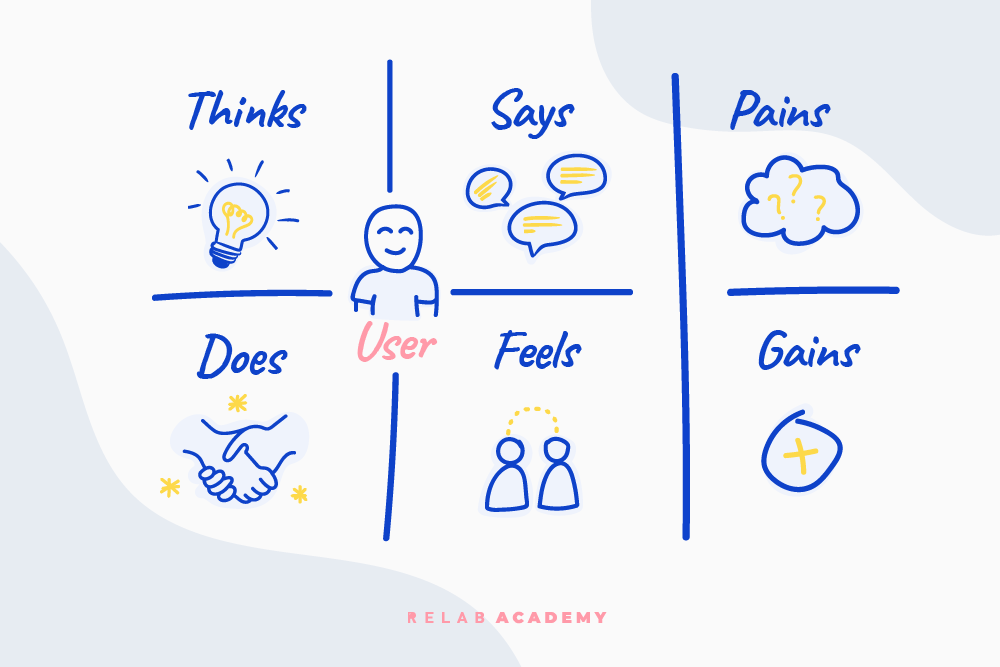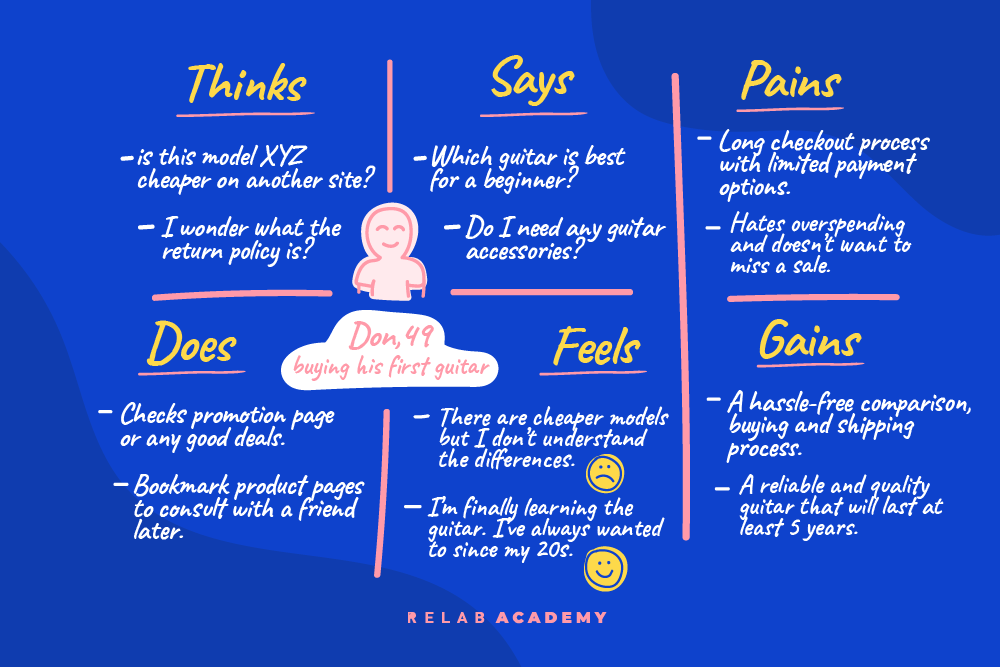Empathy is a valuable skill to have, no matter what profession you are in. It’s the ability to emotionally understand and imagine yourself in someone else’s place.
When designing and building products, empathetic behaviour is almost a requirement. It’s how you start building human-centred products. Product managers, designers and developers need to be able to put themselves in the users’ shoes. There are many methods to do this, and one popular technique is called empathy mapping.
What is empathy mapping?
Empathy mapping is a brainstorming method that lets you explore deeper into your users’ minds and feelings. It is best done as a group exercise, where you will produce a visual diagram, called the empathy map. The empathy map summarises what a user thinks, feels, says, and does. It is a representation of one user persona, or a subset of your customers.
You’ll create empathy maps when:
- Starting the product design process, after conducting user research but before outlining the product plan and requirements.
- Creating user personas or exploring user personas.
- Designing user interview, survey, and feedback questions.
Why create an empathy map?
1. Get everyone on the same page
When it comes to empathising with the users, you want to encourage different perspectives to have a wider understanding of the issue. But when it comes to building products, designers, developers, managers, and marketers need to be on the same page. The empathy mapping exercise is about extracting everyone’s opinions, and then agreeing to the same base line.
2. Remove unnecessary biases and judgements
We are all human. We tend to assume too much or too little and jump to conclusions. By discussing our perspectives, we can identify and eliminate societal and personal biases that might lead us down the wrong path when we are building the product. One of the design thinking pillars is to question all the assumptions we make.
3. Build stronger personas
Empathy mapping is a great tool to start creating user personas, after you’ve done all the research, interviews, and surveys. They are also handy when you’re stuck with a design issue and need to expand the user persona further. It helps to uncover needs, goals, and behaviours you hadn’t thought of before. However, an empathy map is not a substitute for a user persona. Rather, it is a tool that helps you build a more accurate persona.
4. Improve your user research process.
Empathy mapping will enrich your research process by revealing important questions you should be asking your customers. As you delve into the users’ thoughts and emotion, you will discover more areas you should be probing and situations you didn’t think of before, that will improve how you conduct user research.
How create an empathy map?
1. Prepare your data
First you need to define the goal of drawing the empathy map. You may be trying to create a persona, defining the product vision, or exploring a new feature. Make sure you focus on one persona per map. If you have 3 distinct user personas, you will need to draw 3 empathy maps.
Gather all previous user interviews, research, and surveys for this exercise. They should be easy to understand for anyone. You can summarise and share the main points prior to the group session. You can even invite a user to the empathy mapping exercise.
2. Draw the empathy map

Using a whiteboard, draw the quadrants of the empathy map. You can use templates on Mural if you’re running a remote session.
These are the main elements of an empathy map:
- Title: This is the situation that your user is facing.
- Thinks: This quadrant is to capture the thoughts of your user.
- Feels: This quadrant is to capture their emotional state such as doubts, excitement, etc.
- Does: This quadrant is to capture the user’s behaviours. You can also note down the reaction to what they see and hear.
- Says: This quadrant is to capture what they might say in this situation. You can also note down the response to what they see and hear.
- (Optional) Pains: You may also capture their pain points.
- (Optional) Gains: You may also include their goals and motivation.
3. Write your observations
Get everyone to think and write their observations on sticky notes and stick them in a quadrant. This is also easily done if you’re doing a remote session, using tools like Miro and Mural. Don’t worry if you place it in the wrong section. We can sort that out later. This stage is about getting as many relevant opinions as possible.
You’d want to tune up your empathy antennae for this, and really imagine yourself as the user. Remember, you’re not answering what you would think, feel, say and do. You are answering how the user may think, feel say and do, given all the research and assumption you have in hand. If your persona is a 15-year-old kid, then you need to imagine being a teenager again.
Here are a few examples of what you may put in each section. In this imaginary situation, the user is a man in his 40s, who wants to learn how to play a guitar and is choosing the right guitar to buy on an ecommerce site.
Thinks
- “Is this model XYZ cheaper on another site?”
- “I wonder what the return policy is?”
Feels
- Confused – “There are cheaper models but I don’t understand the differences.”
- Excited – “I’m finally learning the guitar. I have always wanted to since my 20s.”
Does
- Checks promotion page for any good deals.
- Bookmark product pages to consult with a friend later.
Says
- “Which guitar is best for a beginner?”
- “Do I need any guitar accessories?”
Pains
- Long checkout process with limited payment options.
- Hates overspending and doesn’t want to miss a sale
Gains
- A hassle-free comparison, buying and shipping process.
- A reliable and quality guitar that will last at least 5 years.
4. Discuss further
Now, get everyone discussing the observations. You can group similar ones and expand further. Probe vague or ambiguous ones, so you can extract a better finding. Or you could go back to the users and ask them to get clearer answers. By the end of the mapping session, you will have a clearer picture, as well as a better understanding of critical questions you should be asking users








